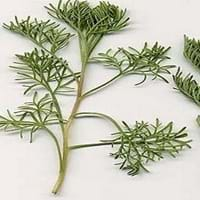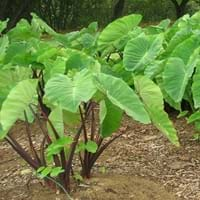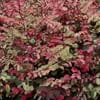Life Span
Perennial
Annual
Type
Shrub
Tender Perennial
Origin
Southern Europe
Southeastern Asia
Types
not available
Eddoe taro, Dasheen taro
Number of Varieties
Not Available
Habitat
Temperate Regions
agricultural areas, Hillside, Warm and moist climatic conditions
USDA Hardiness Zone
5-8
10-11
Sunset Zone
2b, 3a, 3b, 4, 5, 6, 7, 8, 9, 10, 11, 12, 13, 14, 15, 16, 17, 18, 19, 20, 21, 22, 23, 24
H1, H2, 22, 23, 24
Habit
Upright/Erect
Clump-Forming
Minimum Height
Not Available
Minimum Width
Not Available
Flower Color
Yellow, Gray
White, Green
Flower Color Modifier
Not Available
Not Available
Fruit Color
Non Fruiting Plant
Red
Leaf Color in Spring
Gray Green
Dark Green, Ivory
Leaf Color in Summer
Gray Green
Dark Green, Ivory
Leaf Color in Fall
Gray Green
Dark Green, Ivory
Leaf Color in Winter
Not Available
Dark Green, Ivory
Leaf Shape
Long hair-like leaves
V-Shaped
Plant Season
Spring, Summer, Fall
Spring, Summer, Fall, Winter
Sunlight
Full Sun
Partial shade, Full Shade
Type of Soil
Loam
Loam, Sand
The pH of Soil
Neutral
Acidic, Neutral
Soil Drainage
Well drained
Well drained
Bloom Time
Late Summer
Indeterminate
Tolerances
Not Available
Heat Tolerance, Humidity, Salt and Soil Compaction, Shallow soil
Where to Plant?
Ground, Pot
Container
How to Plant?
Cuttings, Seedlings
From Rhizomes
Plant Maintenance
Medium
Medium
Watering Requirements
Average Water Needs, Keep the Soil well drained
Needs 2-3 times watering per week, Needs a lot of water initially
In Summer
Lots of watering
Lots of watering
In Spring
Moderate
Moderate
In Winter
Average Water
Average Water
Soil pH
Neutral
Acidic, Neutral
Soil Type
Loam
Loam, Sand
Soil Drainage Capacity
Well drained
Well drained
Sun Exposure
Full Sun
Partial shade, Full Shade
Pruning
Cut back old stems to the ground, Remove damaged leaves, Remove dead branches, Remove dead leaves
No pruning needed
Fertilizers
All-Purpose Liquid Fertilizer, Complete balanced fertilizer
All-Purpose Liquid Fertilizer, Less fertilizing
Pests and Diseases
Free of serious pests and diseases
Aphids, Rats, Snails
Plant Tolerance
Drought
Heat Tolerance, Salt and Soil Compaction, Shade areas
Flowers
Insignificant
Insignificant
Flower Petal Number
Not Available
Not Available
Foliage Texture
Medium
Bold
Foliage Sheen
Matte
Glossy
Attracts
Not Available
Aphids, Bugs, Not Available, Snails
Allergy
Skin irritation
Swelling in mouth, Throat itching
Aesthetic Uses
Farmland, small hedge, Wild gardens
Showy Purposes
Beauty Benefits
Not Available
Poison Ivy, Skin cleanser, Weightloss
Environmental Uses
Air purification
No fertilizer, pesticides, or herbicides needed, Prevent weeds
Medicinal Uses
Antiseptic, Digestive, Liver problems, Skin Disorders, Tonic
Aging, Laxative, Weight loss
Part of Plant Used
Branch, Fibres, Flower Stalk, Gum, Leaves, Twigs
Leaf Stalks, Leaves
Other Uses
Oil is used in mosquito repellents, Used for fragrance, Used to make hair tonic
Used As Food, Used as Ornamental plant
Used As Indoor Plant
No
No
Used As Outdoor Plant
Yes
Yes
Garden Design
Herb, Vegetable, Mixed Border, Rock Garden, Wall
Container, Feature Plant, Groundcover, Houseplant, Mixed Border, Tropical
Botanical Name
ARTEMISIA abrotanum
ALOCASIA micholitziana
Common Name
lad's love , southern wormwood , old man , boy's love , appleringie , sitherwood
Elephant Ear, Taro
In Hindi
southernwood
अरवी
In German
Eberraute
Colocasia (Pflanzengattung)
In French
aurone ou citronnelle
Colocasia
In Spanish
Artemisia abrotanum
Colocasia
In Greek
Artemisia abrotanum
Colocasia
In Portuguese
Abrótano
Colocasia
In Polish
Bylica boże drzewko
Kolokazja
In Latin
Southernwood
Colocasia
Phylum
Magnoliophyta
Magnoliophyta
Class
Magnoliopsida
Liliopsida
Family
Asteraceae
Araceae
Clade
Angiosperms, Asterids, Eudicots
Angiosperms, Monocots
Tribe
Anthemideae
Colocasiodeae
Subfamily
Asteroideae
Aroideae
Number of Species
Not Available
Importance of Southernwood and Taro
Want to have the most appropriate plant for your garden? You might want to know the importance of Southernwood and Taro. Basically, these two plants vary in many aspects. Compare Southernwood and Taro as they differ in many characteristics such as their life, care, benefits, facts, etc. Every gardener must at least have the slightest clue about the plants he wants to plant in his garden. Compare their benefits, which differ in many ways like facts and uses. The medicinal use of Southernwood is Antiseptic, Digestive, Liver problems, Skin Disorders and Tonic whereas of Taro is Aging, Laxative and Weight loss. Southernwood has beauty benefits as follows: Not Available while Taro has beauty benefits as follows: Not Available.
Compare Facts of Southernwood vs Taro
How to choose the best garden plant for your garden depending upon its facts? Here garden plant comparison will help you to solve this query. Compare the facts of Southernwood vs Taro and know which one to choose. As garden plants have benefits and other uses, allergy is also a major drawback of plants for some people. Allergic reactions of Southernwood are Skin irritation whereas of Taro have Swelling in mouth and Throat itching respectively. Having a fruit bearing plant in your garden can be a plus point of your garden. Southernwood has no showy fruits and Taro has no showy fruits. Also Southernwood is not flowering and Taro is not flowering . You can compare Southernwood and Taro facts and facts of other plants too.





